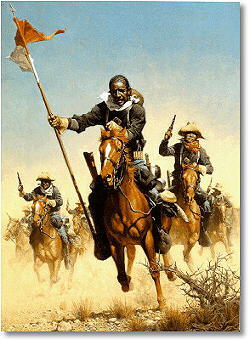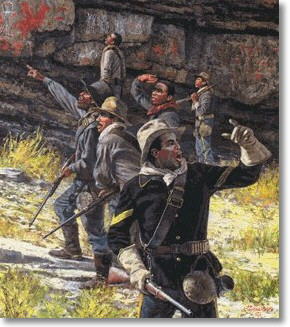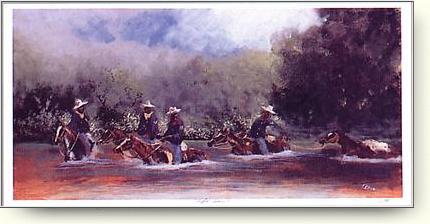|
|
Buffalo Soldiers





Black soldiers fought in Washington's army during the War of Independence,
and served with Andrew Jackson at New Orleans in 1815. Late in 1861, Colonel
T. W. Higginson took command of the First Regiment of South Carolina
Volunteers, the first Black regiment in the service of the United States.

On June 28, 1866, an Act of Congress authorized the creation of two cavalry
and four infantry regiments, "which shall be composed of colored men." They
were organized as the 9th and 10th Cavalry and the 38th through 41st
Infantry. The 9th and 10th Cavalry would go on to play a major role in the
history of the West, as the "Buffalo Soldiers."
On September 21, 1866, the 9th Cavalry Regiment was activated at Greenville,
Louisiana under command of Colonel Edward Hatch and the 10th Cavalry
Regiment at Fort Leavenworth, Kansas under command of Colonel Benjamin
Grierson.
The term "buffalo soldiers" came from Cheyenne warriors who first
encountered these black men in blue uniforms, whose dark skin and thick hair
resembled the buffalo. The initial strangeness turned to respect buffalo
soldiers participated in most of the campaigns against hostile tribes,
earning themselves battle honors and no less than 18 Medals of Honor for
individual heroism.
The Buffalo Soldiers consistently received some of the worst assignments the
Army had to offer. They also faced fierce prejudice to both the colors of
their Union uniforms and their skin by many of the citizens of the post-war
frontier towns. Despite this, the troopers of the 9th and 10th Cavalries
developed into two of the most distinguished fighting units in the Army.
After the Indian campaigns, the buffalo soldiers continued their outstanding
service during the Spanish-American War and along the Mexican border. For
three years during the Philippine Insurrection, portions of all four black
regiments and two black volunteer regiments saw action. They were
distributed among army posts throughout the archipelago, the black soldiers,
both regulars and volunteers, participated in military operations from
Northern Luzon to Samar.
Elements of the 9th and 10th went on to fight in Cuba, and took part in the
charge up San Juan Hill. The 10th Cavalry took part in the expedition
against Pancho Villa, with General Pershing.
In addition to their fine combat record, the buffalo soldiers steadfastly
performed the other duties. They explored and mapped vast areas of the
southwest and strung hundreds of miles of telegraph lines. They built and
repaired frontier outposts around which future towns and cities sprang to
life. Without the protection provided by the 9th and 10th Cavalries, crews
building the ever expanding railroads were at the mercy of outlaws and
hostile Indians.
Despite its dreariness, hardships, boredom, and fatigue, they had the lowest
desertion rate of the frontier Army; on $13.00 a month, meals, and a roof,
if available.
The two regiments were formed into the 4th Cavalry Brigade in 1941,
commanded by General Benjamin O. Davis, Sr., at Camp Funston, Kansas. The
horse cavalry regiments were disbanded in 1944, and with them, the long and
proud history of The Buffalo Soldiers.
The End |
|
|
|
|
 Native American Nations
Native American Nations
